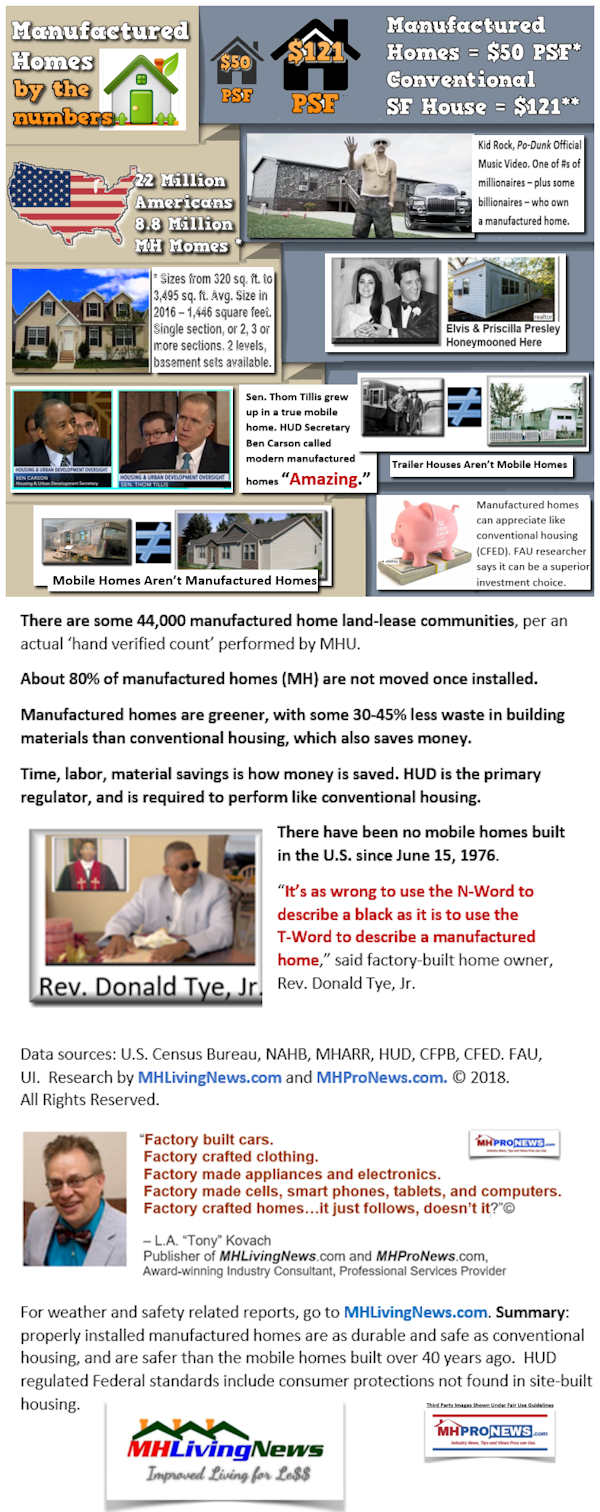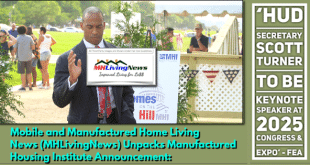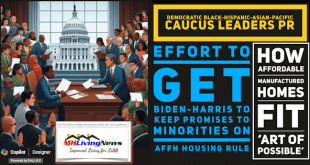Foreward. Susan M. Wachter, writing as Assistant Secretary for Policy Development and Research for the U.S. Department of Housing and Urban Development (HUD) said, “Most new homes in the United States are site-built to State and local codes, but an increasing number are “manufactured homes,” designed and constructed to meet the requirements of the preemptive Federal Manufactured Home Construction and Safety Standards. For decades, manufactured housing has provided a low-cost alternative to conventional site-built construction. Evolution of the manufactured home is eliminating many of the differences with site-built homes, and changes in zoning laws are allowing use of manufactured homes outside of land zoned for parks in a growing number of States.”
The research Wachter referenced was prepared by the NAHB Research Center. Meaning, conventional housing builders’ research arm did the favorable report on manufactured homes, which is linked here as download.
Executive Summary on Linked 3rd-Party Research
For over 2 decades, manufactured homes have been recognized by third-party research – such as the NAHB research document referenced above – as a positive solution to the affordable housing crisis.
There is significant misinformation that exists. That’s why third-party research is useful to clear up the confusion.
This column links a sampling of some of the reports in the last 2 decades, from 2018 looking backward, that documents that manufactured homes by law must perform to the same standards as conventional housing, and does so at a fraction of the price.
The interview below with Bill Matchneer, JD, a prior administrator for HUD of the Office of Manufactured Housing Programs (OMHP) makes the same points in a video that also illustrates the points being made.
The infographic that follows summarizes information compiled in 2018 on manufactured home terminology.

Media, Researchers, Investing or Expert Witness Needs? Contact Information
Reporters, researchers, or investors can contact our publisher L. A. ‘Tony’ Kovach – a widely recognized expert on manufactured housing – by email at this link here. Please put ‘Media Inquiry’ or ‘Research Inquiry’ or ‘Investor inquiry’ or ‘Expert Witness’ in your email’s subject line.
Tony Kovach has been cited in 3 of the reports linked below. He has authored articles research summaries published on Value Penguin linked here, on The Hill’s Congress Blog on manufactured home lending, and in a new Op-Ed that addressed the controversy about John Oliver’s viral “Mobile Homes” video published at this link here. There are several mainstream media reports that quote him. Tony Kovach’s one of the most endorsed and recommended professionals in manufactured housing, as his LinkedIn profile linked here demonstrates. That said, he is seen by some as provocative in the sense that he seeks to tell it like it is, and doesn’t shy away from controversial topics that deal with manufactured home and manufactured home living. When writing, please provide your title, interest, and any relevant website in your initial message.


Research for Consumers, Affordable Housing Advocates, Public Officials
Lawrence L. Thompson, then General Deputy Assistant Secretary for Policy Development and Research at the Department of Housing and Urban Development (HUD) said the following.
“There is a tremendous need for new homes in America’s cities and towns. To meet this demand, the home building industry has developed and adopted many technological innovations to provide new homes more quickly and more efficiently while still keeping homes affordable and of a high quality. New techniques, materials, tools, and organizational methods are particularly common in the “factory-built” housing world. Manufactured and modular housing–the most common forms of factory-built housing are now common alternatives to traditionally constructed homes due in large part to these improvements.”
Thompson continues, “The U.S. Department of Housing and Urban Development (HUD) has created this publication, A Community Guide to Factory-Built Housing, to share these alternatives with a wider audience. Both private and non-profit housing provider groups as well as community developers of all kinds benefit directly by these changes. Factory-built homes are increasingly built in urban and suburban areas–places where it was often difficult to build in the past. So, in addition to detailing the technical and design options that are now available, this publication also discusses the social, financial, and local considerations that a developer will need to address.”
He wraps up his introduction to “A COMMUNITY GUIDE TO FACTORY-BUILT HOUSING” – which was prepared for the U.S. Department of Housing and Urban Development Of?ce of Policy Development and Research by saying: “As a guide to this expanding housing market, this publication also helps you consider factory-built housing as a cost-effective solution to a city’s housing needs, and describes resources and networks that can support you. Easy-to-read and comprehensive publications like this directly support the needs of home building developers, particularly those serving low-income communities. We invite you to read this and all of our community-directed reports and look out for further work from HUD in this field.”
There are numbers of such third-party, privately or publicly commissioned research reports that have been done in the last quarter-century about manufactured homes. This article will post several additional third-party research documents.
Realtor University – National Association of Realtors
Let’s start with a quote from a research document from 2018, provided by the National Association of Realtors (NAR). We’ll note that the NAR report is available at this link here. Author Scholastica ‘Gay’ Cororaton thoughtfully cited our publisher, L. A. ‘Tony’ Kovach in the first footnote on her research, which begins on page 48.
Examining Community Attitudes Toward Manufactured Housing
The next research report to consider is by Lisa Tyler. Tyler is reportedly the first Ph.D awarded in over a decade who’s subject matter is specifically connected to the manufactured home industry. It’s called Examining Community Attitudes Toward Manufactured Housing Lisa Tyler Walden University, and is dated in 2015.

“Despite the need for affordable housing, consumers have failed to recognize manufactured housing as a viable alternative to site-built housing,” Dr. Tyler said.
Her final acknowledgement said, “I would like to acknowledge the manufactured housing industry professionals who have supported and assisted me throughout this journey. I am incredibly appreciative of Tony “L.A. Tony K” Kovach’s insight, feedback, and valuable opportunities to generate interest and support for my research topic. I am an honored recipient of your generosity in sharing your extensive knowledge and experience.” By way of explanation, L. A. ‘Tony’ Kovach included now Dr. Tyler in expert panel discussions he organized and promoted her study here on MHLivingNews and on our professional site, MHProNews as well. Her research is available at this link here.
Government Accountability Office (GAO) on Manufactured Homes
In 2014 there was independent research done by the Government Accountability Office (GAO) about manufactured homes. We’ve periodically used the following graphic from that research.

That research by the GAO is linked here.
Consumer Financial Protection Bureau CFPB White Paper on Manufactured Homes and Financing
Another research document in 2014 was the Consumer Financial Protection Bureau’s (CFPB) white paper on manufactured housing and financing. It says that manufactured homes are “…First, it is an important source of affordable housing, in particular for rural and low-income consumers.” It also notes that “Compared with site-built housing and mortgage finance generally, data and information on manufactured housing are relatively sparse.”
In footnote 15, of the CFPB research is a reference to an article here on MHLivingNews. “L.A. “Tony” Kovach, Sensationalistic ‘Cold Hard Lessons of Mobil Home U” New York Times Article by Gary Rivlin Draws Manufactured Home Industry Ire, Desire, and Fire, Manufactured Home Living News (2014), available at https://manufacturedhomelivingnews.com/sensationalistic-cold-hard-lessons-of-mobile-home-u-new-york-times-
Let’s note that several of the problems cited by the CFPB could arguably be traced back to Berkshire Hathaway brands operating in the industry. See examples of those linked here or more in the related resources, further below. The CFPB white paper is linked here.
A solution to issues raised by the CFPB are routinely promoted by the Manufactured Housing Association for Regulatory Reform (MHARR), which promotes the full implementation of the Duty to Serve (DTS) Manufactured Housing mandated by the Housing and Economic Recovery Act (HERA) of 2008.

Enhanced Preemption
On November 13, 2003, in a letter to the HUD Secretary Mel Martinez, 6 Congressional Representatives signed a letter saying that manufactured housing’s enhanced preemption needed to be honored.
They closed with these words, “these combined changes have given HUD the legal authority to preempt local requirements or restrictions which discriminate against the siting of manufactured homes (compared to other single family housing) simple because they are HUD-code homes. We ask that HUS use this authority to develop a Policy Statement or regulation to address this issue, and we offer to work with you to ensure that it comports with Congressional intent.”
That letter and a cover letter to HUD Secretary Carson citing their authority under enhanced preemption is linked here.
That’s important, because the bulk of these documents don’t adequately address the issue of enhanced preemption. An example from the MHARR website is linked below.
That said, Regulatory Barriers is another HUD PD&R report that documents how manufactured homes appreciated side-by-side with conventional housing.

The photos above and below are from that document. See that report linked here.

Community Guide to Factory Built Housing
These charts and the photo below are from the “A COMMUNITY GUIDE TO FACTORY-BUILT HOUSING”
That document is available at a download linked here.

“Millennial Housing Commission concluded that “During the 1990s, manufactured housing accounted for one quarter of all housing starts and, from 1997 to 1999, 72 percent of new units affordable to low income home buyers.”
Ford Foundation
That survey is where the featured image at the top of this article was drawn from, and the report is found at this link here. It praises manufactured homes in several levels as an important resource for affordable housing.
Last But Not Least, Mobile Homes and Earlier Industrialized Housing
There have been no mobile homes produced in the U.S. since June 15, 1976. That’s when the HUD Code for manufactured homes went into effect. That said, even during the mobile home era, there was positive research on “industrialized housing.” See the Operation Breakthrough research by HUD in the early 1970s, linked here.

That should provide plenty of reading for today! Maybe for the next few days? The bottom line is this. When MHLivingNews says that the evidence is there to debunk numerous fears or outdated concerns, this is just a sampling of it. That’s why we could say with confidence some years ago, that the solution to the affordable housing crisis is hiding in plain sight. “We Provide, You Decide.” © ## (Lifestyle news, commentary, and analysis.

Soheyla Kovach co-founder of MHLivingNews, (pronounced like Co-Vatch like a watch with a V) and is a managing member of LifeStyle Factory Homes, LLC parent company to this platform and MHProNews.
Related Reports:
Clicking on text-image graphics will take you to that report.
HBO’s John Oliver on Last Week Tonight Mobile Homes Video, Manufactured Home Communities Fact Check
Why is Seattle Dying? Affordable Housing, Misplaced Compassion, and Manufactured Homes
HUD Study, Analysis of Zoning Discrimination Against Manufactured Housing Sought
 manufacturedhomelivingnews.com Manufactured Home Living News
manufacturedhomelivingnews.com Manufactured Home Living News




































